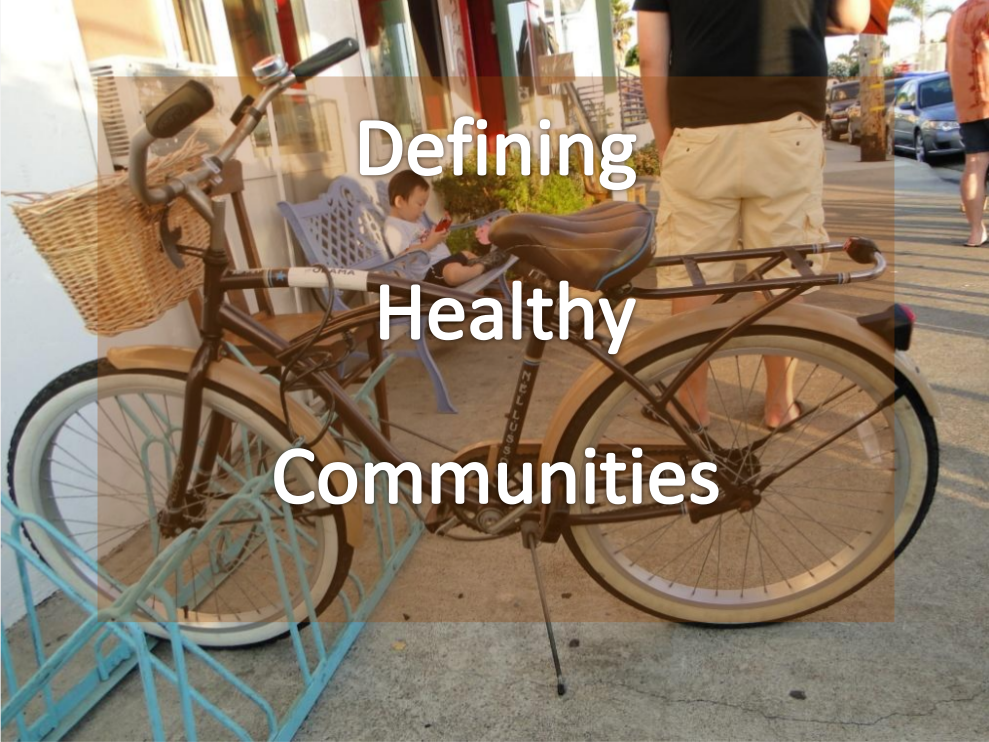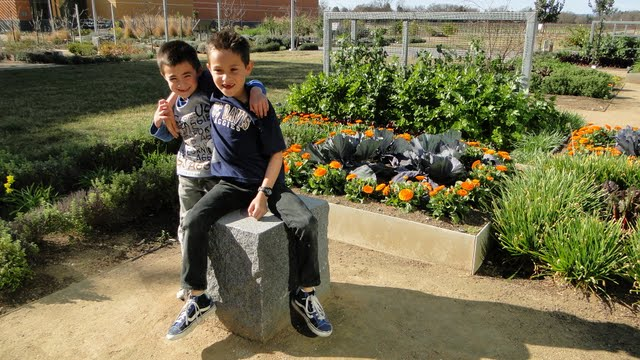California Planning Roundtable
Healthy Communities Work Group

December 2013
Download Final Report
Resources
Defining Healthy Communities
Health is our most valued human asset. Local governments, public agencies, researchers, non-profit, philanthropic and grassroots organizations are increasingly recognizing this emerging maxim and the paramount need to explicitly consider health in all facets of the planning discipline and its various branches.

In the State of California, for many decades, the General Plan and the California Environmental Quality Act (CEQA) have provided for an opportunity to advance public health goals and address negative effects on the public's health resulting from land use planning decisions. Irrespective of the effectiveness of these policies frameworks, health considerations have only been implicit and not fully discussed and/or analyzed.
The growing Healthy Communities movement is expected to touch every jurisdiction in the State of California in the near future, as health outcomes will be a function of policies stemming from SB375 and AB32 legislations, regional transportation planning and Complete Streets legislations. Furthermore, The Governor's Office of Planning and Research (OPR) is considering including health as part of the General Plan Guidelines update to be published in the upcoming months. It is important to note that particular attention on reducing health disparities experienced by the most under-served populations is emerging as a critical strategy for achieving healthy communities.
In an effort to assist the planning community regarding Healthy Communities, the California Planning Roundtable (CPR) has formed a work group (Healthy Communities Work Group) (CPR-HC) to formulate practical actions that will connect information, resources, organizations and individuals revolving around health and planning.

One of the CPR-HC objectives was to consider the meaning of Healthy Communities term. Walkability, safe, affordable housing, environmental equity, access to healthy foods, complete streets, new urbanism, local jobs, access to parkland and open space, clean air and clean water, good schools, safe neighborhoods, access to healthcare, longevity, smart growth, sustainability?All of these notions allude to a few key components of what constitutes a "healthy community." The list can be extensive, and the concept would vary subjectively depending on who is asking and who is answering the question, what is a healthy community?
This was the question posed to the CPR-HC at the 2012 retreat in San Francisco, CA. Although various seasoned members offered useful ideas and attempted to provide a definition, no one was able to offer a widely accepted definition that is or could be used by the planning community.
For this reason, the CPR-HC embarked on a journey to investigate what definitions have been developed and what ideas have been provided to support the concept. Most of the material reviewed in the past few months revealed that definitions are lengthy and originate from the Healthy Cities Movement which was propelled by the World Health Organization (WHO) in the 1980's.

Although the American Planning Association has done extensive work to integrate planning and public health - including a "health" section in the 2012 update to the Policy Guide on Smart Growth (Section G)-it has not published a definition that could aid planners working in this arena or one that could serve as point of departure to understand, embrace and practice healthy communities planning.
After several months of research and on-line communications with planning and public health practitioners via LinkedIn, the Work Group has emerged with a definition that, in great part, is based on the 2010 State of California Health in All Policies Task Force Report to the Strategic Growth Council. This brief definition is a synthesis of multiple concepts that planners and other community health advocates can use as the starting point in the conversation of Healthy Communities. The abbreviated definition is supported by a lengthier, but practical definition that can easily be complemented with other concepts and values coming from whoever wishes to mold his/her own Healthy Communities definition. The definition is designed to serve as a framework for developing community specific policies and strategies to achieve positive health outcomes/impacts through planning.
Furthermore, this definition is the first step in CPR's work to advance healthy communities understanding and applicability in the California planning realm. We consider this work as core principles of healthy communities and a critical component of our on-going work. It will serve as a guidepost and framework for our strategies and resource development to advance healthy communities in cities and counties across the Golden State and beyond.
HEALTHY COMMUNITY: A DEFINITION
“A healthy community is one that strives to meet the basic needs of all residents; it is guided by health equity principles in the decision-making process; it empowers organizations and individuals through collaboration, civic and cultural engagement for the creation of safe and sustainable environments. Vibrant, livable and inclusive communities provide ample choices and opportunities to thrive economically, environmentally and culturally, but must begin with health.”

A Healthy California Community Provides*:
Basic Needs for All:
- Affordable, accessible and nutritious foods and safe drinking water
- Affordable, accessible, high quality health care
- Affordable, safe, integrated, and location efficient housing
- Safe, sustainable, accessible and affordable transportation options
- Safe, clean environment Access to quality schools
- Access to affordable, safe opportunities and spaces for physical exercise and fun activities
- Safe communities, free of crime and violence
Safe, Sustainable Environment
- Clean air, soil, and water
- Green and open spaces
- Reduced greenhouse gas emissions and other pollutants
- Reduced waste
- Affordable and renewable energy resources
- Habitat conservation and renewal
- Nourishes the interrelationship between people, nature and the built environment
Economic and Social Vitality
- Living wage, safe and equitable job opportunities to support individuals and families
- Strong, resilient economy supportive of innovation and entrepreneurial spirit
- Support and investment in the healthy development of children and adolescents
- Access to high quality, affordable education from preschool through college and including vocational opportunities
- Community empowerment through robust social and civic engagement that takes into account diversity and cultural competency
- Opportunities for recognizing the intangible and tangible value of people's history and cultural heritage imprinted in the built and natural environment
- Meaningful public participation opportunities that all segments of the community can access
- Access to opportunities to thrive regardless of income, race, ethnicity, nationality, gender, age, sexual orientation, identity, creed or disability
- Equitable access to opportunities for physical, mental and spiritual well-being and development in a safe environment, especially for women and children
- Promote an understanding of the social determinants of health and health equity as strategies to reduce health disparities affecting the most vulnerable populations
- Opportunities for exercising creativity, artistic expression and fostering imagination.
Efficient Development Patterns
- Sufficient affordable housing development in appropriate locations
- Mix of land uses and built environment that support walking and biking
- Multimodal, affordable transportation choices
- Infill and compact development appropriate to setting (urban, suburban and rural)
- Safe public spaces for social interaction
- Conservation and restoration of open space and preserve agricultural lands
*The bullet points are provided to illuminate the many components of healthy communities and as guiding principles to expand the healthy communities' narrative when engaging in conversations about aspects to consider during planning processes. They should be viewed in the context of existing community conditions and can be prioritized, expanded, adapted and/or quoted as needed.

ACKNOWLEDGMENT
California Planning Roundtable
Healthy Communities Work Group
- Susan Harden, AICP, CMSN, LEED AP, CNU-A, Co-Chair
- Miguel A. Vazquez, AICP, Co-Chair
- Alex Amoroso, AICP
- Coleen Clementson
- Cathy Creswell
- Susan DeSantis
- Alex Hinds
- Tom Jacobson, JD, AICP
- Jeff Loux, PhD
- Simran Malhotra, AICP, Assoc. AIA
- Victor Rubin
- Linda Tatum, AICP
- Woodie Tescher
- Al Zelinka, FAICP
We thank the following professionals for the critical and valuable comments they provided to strengthen this effort:
- Elizabeth Baca
- Victor Becerra
- Mina Brown
- Ruben Cantu
- Alexander Chan
- Lianne Dillon
- Tricia Gehrlein
- Karana Hattersley-Drayton
- Bob Johnson
- Jonathan London
- Luis Lopez
- Laura Roughton
- Casey Tsui
- Robert Voigt

Resources
California Links to Healthy Communities
- California Department of Public Health: Healthy Communities Data and Indicators Project (HCI)
- Strategic Growth Council: Health in All Policies
- California Healthy Cities and Communities Network
- Healthy City
U.S. Links to Healthy Communities
- National Association of State Health Programs
- Office of Disease Prevention and Health Promotion (ODPHP).
- CDC Healthy People in Healthy Communities
- CDC Healthy Places Terminology
- American Planning Association - Planning and Community Health Research Center
Global Links to Healthy Communities
- World Health Organization - Health Determinants
- World Health Organization - Collaborating Centre for Healthy Urban Environments
- Gross National Happiness indicators
- Oxfam Humankind index
- The Community Tool Box: Healthy Cities/Healthy Communities
Health Foundations
- Robert Woods Johnson Foundation - New Public Health
- The California Endowment
Healthy Communities Advocacy Organizations
- Local Government Commission - Healthy Communities Resources and Publications
- ChangeLab Solutions - Healthy Planning
- PolicyLink - Center for Health Equity and Place
- Design for Health
- Healthy Communities Institute
About Healthy Communities
- The Healthy Communities Movement and the Coalition for Healthier Cities and Communities
- Planning and Urban Design Standards - Healthy Cities and Communities
